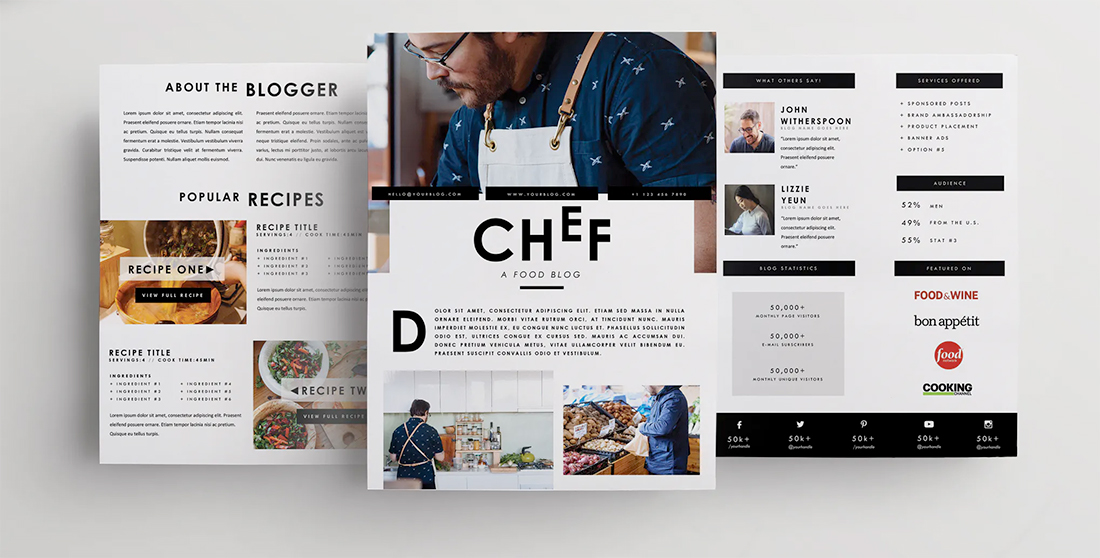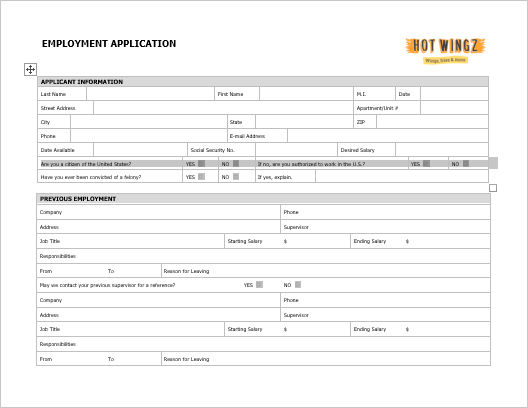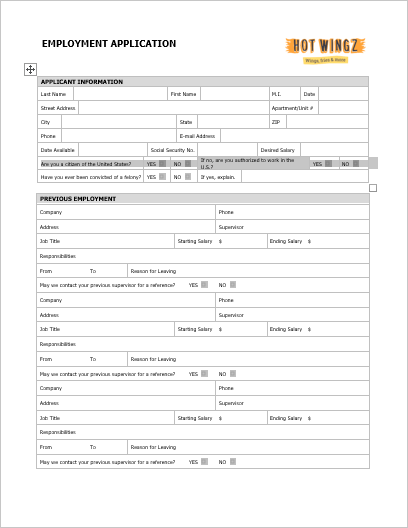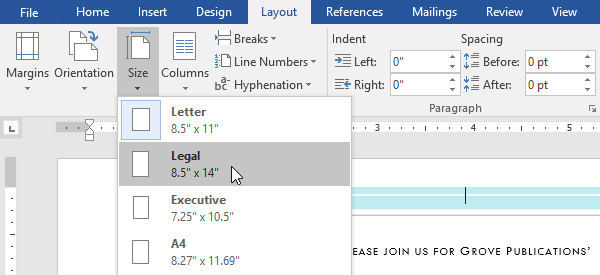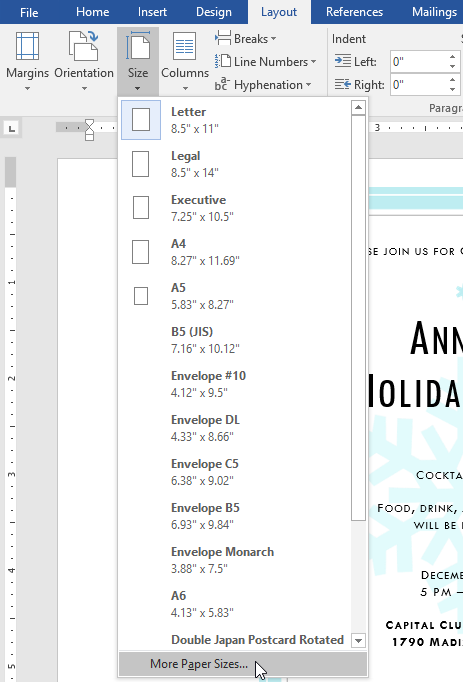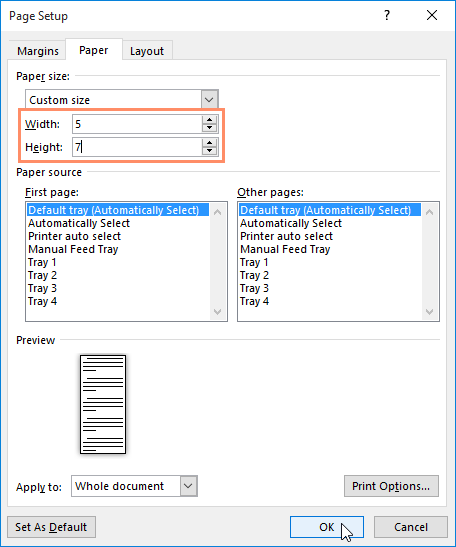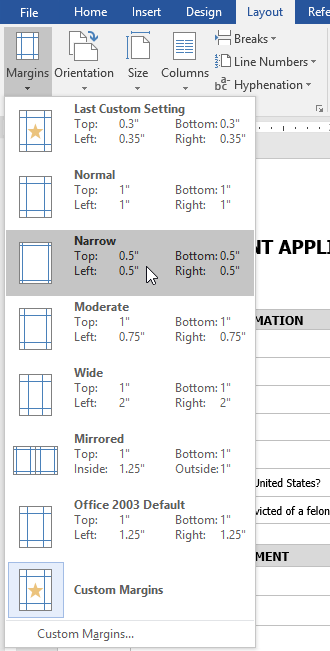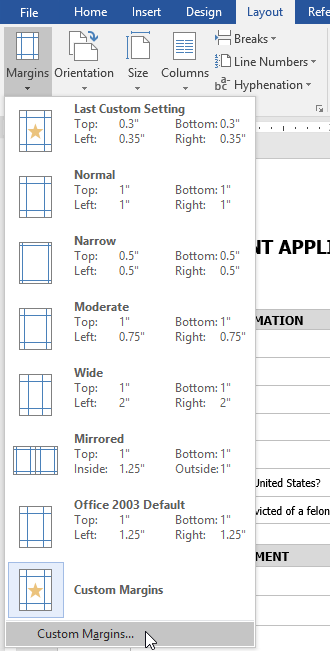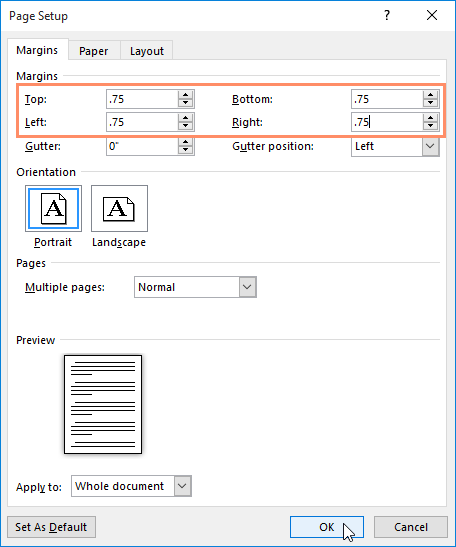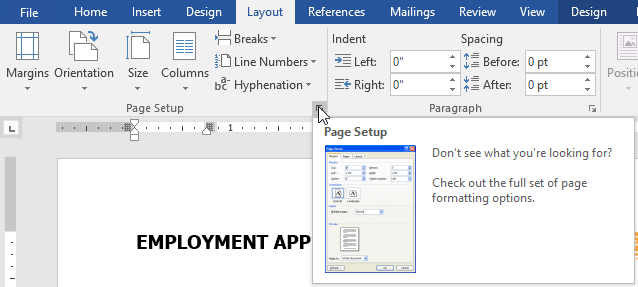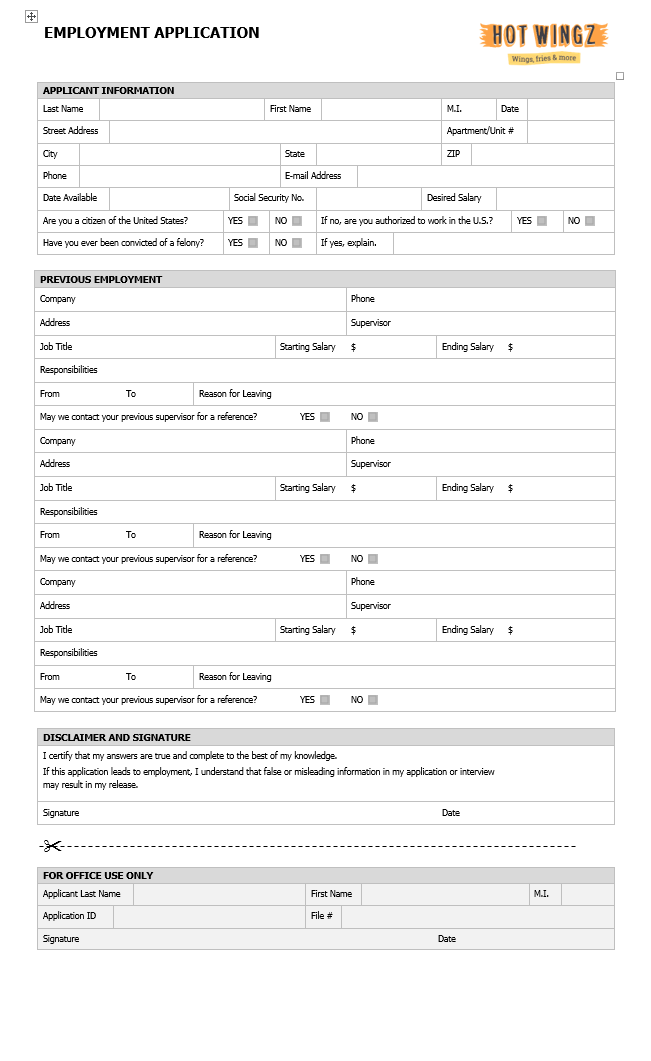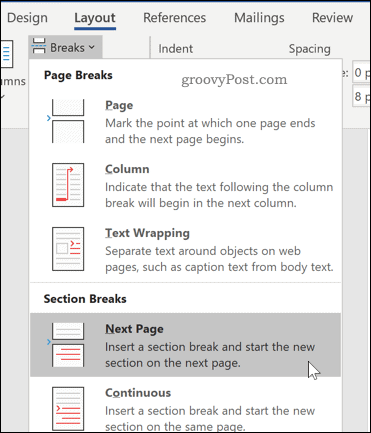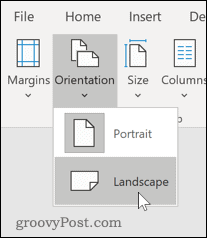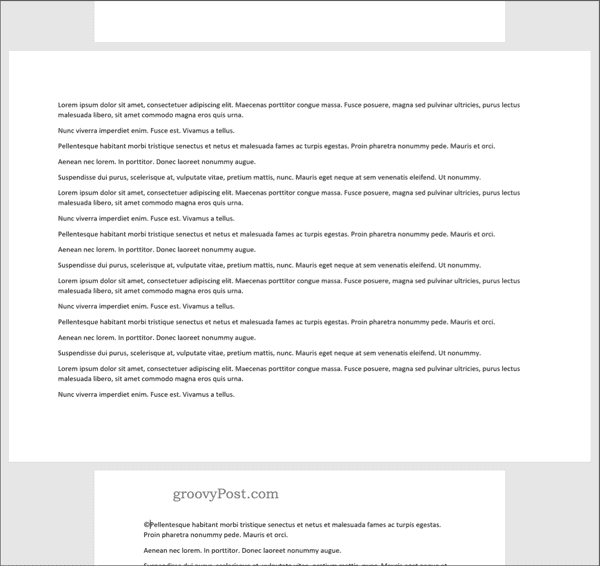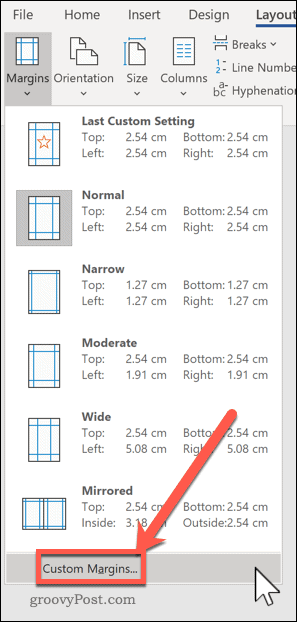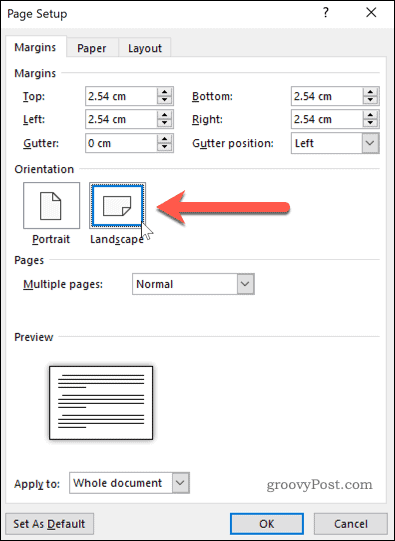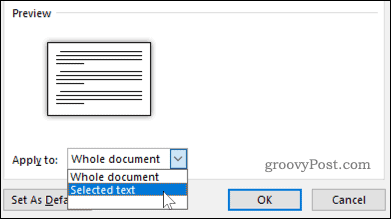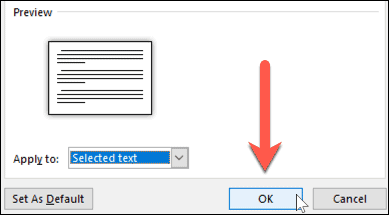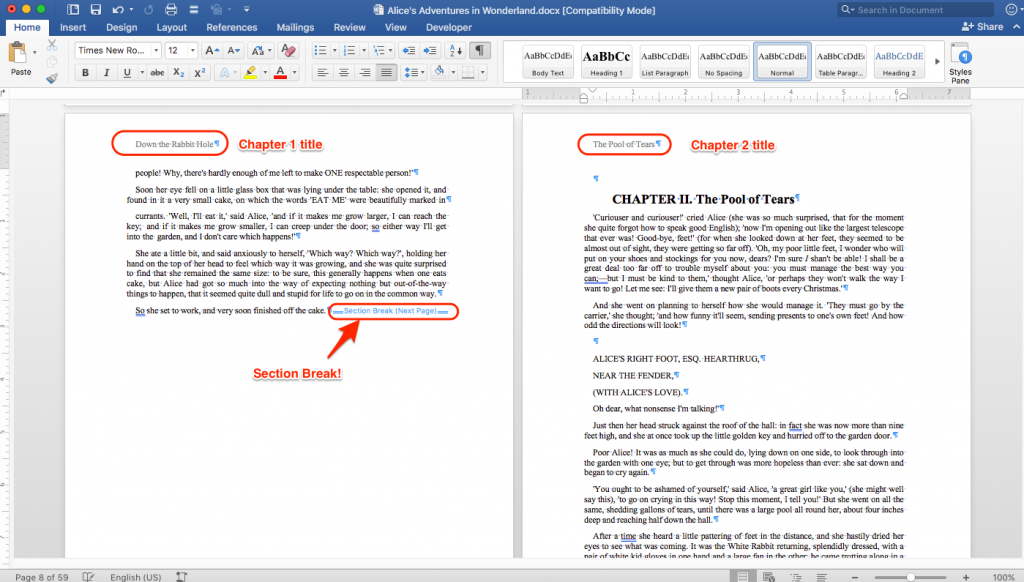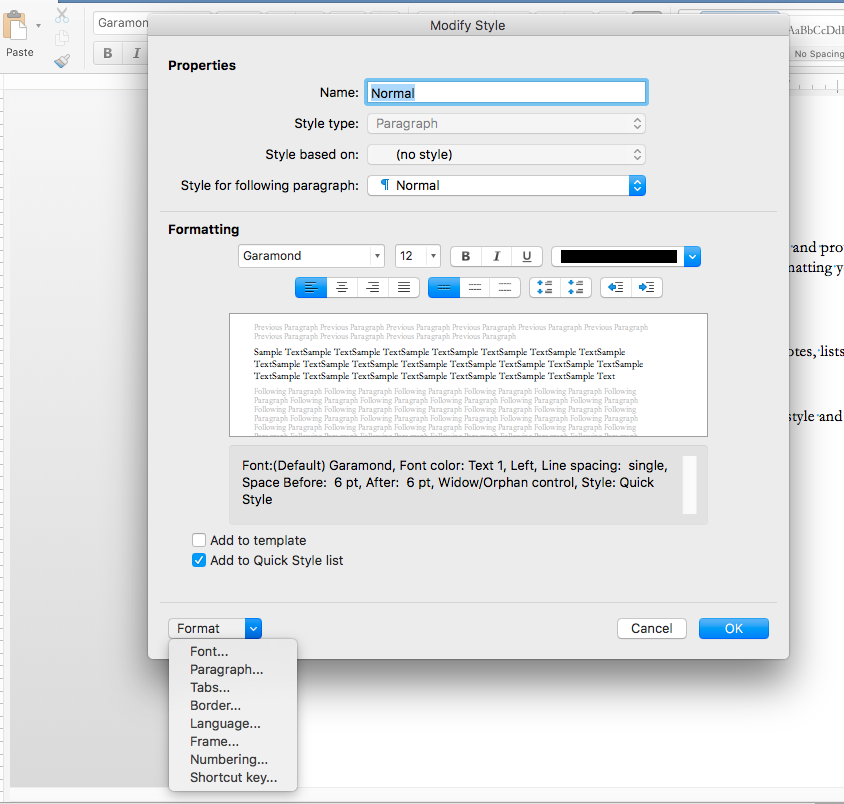When you create a new document in Microsoft Word, it looks decent right off the bat. But sometimes you want to make your page look much better than the default.
Use Microsoft Word’s page layout design tools to make easy-to-read documents that reflect positively on you and your business—even if you’re new to Word.
You can make page layout designs in Microsoft Word from scratch. Or, skip the grunt work by using Microsoft Word templates.
Envato Elements and GraphicRiver are both great sources of print templates for Word. Each template is made by professional designers. Elements makes a compelling offer. Download unlimited templates, fonts, photos, and other creative assets for one fixed subscription price.
But, if you only need the occasional template for MS Word and prefer to pay for each single use, then look to GraphicRiver.
How to Make Awesome Page Layout Designs in Microsoft Word (Video)
If you create or modify documents in Word, you may want to change the standard Microsoft Word layout. There are a number of changes you can make.
Watch this quick screencast to find out what you need to know about Word page layout options:
To learn more about changing page layouts in Microsoft Word, study the complete written tutorial below:
Why Learn About Page Layouts In Word?
Page layout settings in Word determine how your document looks when you print it out. It includes the page orientation, margins, and columns, for example.
It’s important to pay attention to the page layout of your document for several reasons:
- It ensures consistency. This gives your readers a good experience while consuming your document.
- A good page layout makes your document more readable. When your document is aesthetically pleasing and has a consistent look, your audience is more likely to read, comprehend, and remember your content.
- A well-designed document reflects well on you. It reinforces your credibility and authority in your field.
Microsoft Word has robust page settings that allow you to control your page layout design. Everything is designed to be as simple and intuitive as possible. Yet, doing page layout in Word can be daunting if you’re new to the software.
This article breaks things down for you. So, you can follow along, step-by-step, and take control of how your document looks.
Types of Documents You Can Create in MS Word
You can create all kinds of printed documents in Microsoft Word.
Make business documents like:
- resumes
- cover letters
- business letters
- reports
- proposals
- invoices
- certificates
- forms
MS Word is also very handy for creating marketing documents. Create everything from:
- flyers
- brochures
- advertising inserts
- and more
For education or training use Word to prepare:
- handouts
- workbooks
- manuals
- certificates
You can also produce postcards, invitations, newsletters, and signs. If you can print it, then you can whip it up in Word.
In this tutorial, you’ll learn how to use Microsoft Word’s page layout tools to produce the print materials you need.
How to Work With Templates to Quickly Change Your Design
The quickest way to change or apply a page layout is by using a print template for Word. For the examples below, we’ll be using the SEO Proposal template from Envato Elements.
When looking for a print template for Word, it’s a good idea to choose one that uses paragraph and character styles. The styles feature will allow you to quickly format text even in a long document.
Below are some roundups of Microsoft Word templates you can choose from:
Now that you’ve chosen a template with a good page layout in Word, it’s time to learn how to use it.
1. Download the Template
Download the template of your choice to your computer’s hard drive. Unzip the file, then copy the template. This way, you’ve got the original template file intact, if you want to revert to it.
2. Customize the Template With Your Own Content
Replace the text with your own information.
If you want to change the text formatting, change the settings for fonts and paragraphs.
To add your own image, click on an image placeholder. The Format Picture dialog box opens. Under Fill, select Picture or texture fill. Under Picture source, click Insert….
Find and select the image you want to use. Click Insert.
Now, the image is inserted.
To replace an existing logo on the template, click on the logo, then click on the Picture Format tab.
Click the Change Picture button on the ribbon. Find and select the logo file, then click Insert.
If necessary, click-and-drag one of the handles of the logo to resize it.
Next, I’d like to change the color of the rectangle on the cover page. To do that, select the shape, then click the Shape Format tab.
The Shape Format ribbon is displayed. Click on the drop-down arrow beside the Shape Fill button. Select from the color options shown or click More Fill Colors… to specify the color you want to apply.
This is what the customized proposal cover looks like now:
Repeat these steps to customize the other pages of the template.
As you can see, when you start with a template for Word most of the design and page formatting decisions are already made for you by the template creator.
But, if you prefer to start your document from scratch, follow the steps below to change the default page format settings.
Type or paste your text into the document. Apply text and paragraph formatting to modify settings for fonts, spacing, alignment, and more. Then, you can move on to the page layout.
3. How to Set the Microsoft Word Page Orientation as Portrait or Landscape
To set the Microsoft Word page orientation of your document, go to File > Page Setup….
The Page Setup dialog opens. Click on the button for either Word portrait or landscape layout orientation.
4. How to Set the Print Size of the Paper
From the Microsoft Word Page Setup dialog, you can also change the paper size when you print the document. Click on the Paper Size field to show the different paper size choices available.
Select the size you wish to use. You can also click Manage Custom Sizes… to specify your own size.
5. How to Split Your Text into Multiple Columns
Sometimes you may want to divide your text into columns. This can make the document more readable and adds variety to an otherwise monotonous layout. Columns are popular in magazines, newsletters, and similar types of materials.
Arrange the Entire Document into Columns
To change the MS Word layout to columns, follow these steps:
1. Go to Layout > Columns.
The Columns dialog box opens.
2. Select one of the Presets or manually set the:
- number of columns
- width and spacing
- apply to the whole document or from that point forward
3. When you’re happy with the settings, click OK.
Apply Columns to a Part of the Document
You can also apply columns to only a specific part of the document.
1. Select the text you wish to display in columns.
2. Go to Layout > Columns.
3. In the Columns dialog box, choose the settings you want to apply.
Notice that you now have the option to apply the column settings to Selected text. Click OK.
Now, only the selected text has been broken into two columns. The rest remains in one column.
6. How to Add Page and Section Breaks
Sections in Microsoft Word enable you to apply different layouts to different parts of your document. This is useful for making creative layouts, especially to long documents.
Insert a Page Break in Word
A page break separates text, so that anything after the break is moved to a succeeding page. It’s useful for dividing up a document into chapters and sections.
To insert a page break, place the cursor at the point where you want the break to be, then go to Insert > Break > Page Break.
In our sample document, the title page is now on a separate page from the rest of the text.
Insert a Section Break in Word
If you wish to apply varying formatting on different parts of the document, then you’ll want to break it into sections. This includes varying the columns, headers and footers, pagination, borders, and other settings.
To create a section break, place the cursor where you would like the section break to be. Go to Insert > Break > Section Break.
Select the type of section break you want to insert:
- Section Break (Next Page) creates a section break and moves the next section into a new page.
- Section Break (Continuous) keeps the two sections on the same page while allowing you to apply different formatting settings for each.
- Section Break (Odd Page) starts a new section on the next odd-numbered page.
- Section Break (Even Page) starts a new section on the next even-numbered page.
Take Control of Your Page Layouts with Microsoft Word
Use Microsoft Word’s page layout tools to give your documents a consistent, readable, and professional look. You don’t have to be an expert in Word to take better control of your document’s page layouts. With Microsoft Word’s page layout tools, you can make any document look the way you want it to.
You don’t have to start from scratch, either. You can have professional designers make most of the design and layout decisions for you by using print templates for MS Word. If you want unlimited downloads of templates as well as photos, fonts, icons, and other creative assets—all for one small, fixed fee—then Envato Elements is the best source for you.
For one-off Word templates and other desktop publishing tools, look to GraphicRiver. Here, you can access everything you need to create impressive print materials on a pay-per-use basis.
And when you use a template, the skills you learned in this post will help you customize and adapt it to your needs.
Editorial Note: Video added by Alexis (Lexi) Rodrigo.
If you are ready to amp up your designs in Microsoft Word, this is the right place. Here – with templates as examples – we are going to look at a variety of ways you can create more modern, professional-looking page layout designs using this common tool.
Microsoft Word is capable of so much more than you might expect with page layout. You can build modern, on-trend documents, and push the software further than ever before.
Forget the old days of Word Art and choosing between six fonts. Let’s take Microsoft Word into a new world of improved design and typography!
1. Asymmetrical Grids
Get out of the default template and try an asymmetrical grid for a look that will create a fresh look for design projects in Microsoft Word.
When it comes to creating a grid, consider smaller columns as the foundation so that elements will still have a sense of organization and place, without having that split-down-the-middle look.
Another thing to think about with grids is creating both horizontal and vertical grids. These imaginary lines are the secret to organizing content in a visually meaningful way.
2. Infographics
A common theme in design is “show, don’t tell,”
Infographics are the way to do that, and you can design and include them in Word documents, from one-page brochures to multi-page booklets.
Think carefully about infographics in the planning process to keep information easy to digest and understand. Use maps, numbers, charts, and icons to help show the information your document is designed to convey.
3. Gradients
Gradients are the color trend that we can’t get enough of. You can use them in designs for Word documents for a truly modern feel.
From bright monotone gradients that move from light to dark hue to multi-color options, you can find an application for almost any color variable.
Gradients can be used for borders, big text elements, backgrounds, or other visual elements as you see fit.
Take particular care with gradients if you plan to print the Word document to ensure that your color choices will look as intended on paper.
4. Monotone Color Palettes
Monotone color palettes have a beautiful simplicity that just works. Using dark and light variations of a single color feels classic and inviting.
A monotone feel can also solidify brand elements and images and avoid that “plain Word doc” look.
Even with a monotone palette, don’t feel like you have to have a wide range of hues. Pick a color and a handful of variations to use in the design. For most projects, that’s enough.
5. Layers
Layering is a fun and practical effect that brings design elements in the two-dimensional space to life. This design trend has been popular in website design for some time and can work just as well with Word documents and printed layouts.
The trick to using layers is to overlap elements without making the design feel cluttered. Continue to use space and your underlying grid to ensure that everything has a place and it doesn’t look like a smattering of parts were just thrown on the canvas.
Layers can also begin to look and feel heavy if you aren’t careful, so take care with placement and visual weight of colors, typefaces, and images so that everything maintains clear readability.
6. Minimal Aesthetic
White space never goes out of style.
A minimal approach with well-planned space establishes a design that’s easy to understand and follow. It’s something that doesn’t often happen with Word documents, where we have almost been “trained” to fill all the space in a document.
Break out of that mold with open space around elements and in the page gutters so that everything has a seamless flow and light style.
Don’t forget to use a typography style that matches the minimal feel as well. (A simple sans serif can be a nice option.)
7. Color Overlays
Color overlays can be paired with color or black and white images or against other colors with an overprint look.
Putting together blocks of color adds visual interest – particularly with fun shapes such as in the example above – when you don’t have a lot of other artwork to finish out the design.
If you plan to use color overlays, stick to one or two colors from your brand palette. Using too many colors with this style can get overwhelming because color takes on all kinds of tints and tones when used as an overlay.
A tight palette will likely serve you better than a more expansive one here.
8. Bold Color Palettes
Bold, high-contrast color palettes are an immediate attention-getter. (And something that’s not generally expected when it comes to designing Word documents.)
Boldness isn’t always defined by color alone. Boldness can also be the combination of color choices or the display contrast from the pairing.
The black and white resume template, above, with a simple yellow line, is bold and striking. But there’s not a lot of color. A small accent adds an amazing level of boldness without being over the top.
9. Clean Typography
For most designers working in Word, the end goal of the document is to create something that people will read. That starts with clean, simple typography that’s highly readable and understandable.
Often, that’s not just one font, size, or style. It’s using different levels and layers of typography to create an architecture that helps people move through the document in the right order with an understanding of the content.
One of the best ways to accomplish this is with type size. A trend in typography is to use oversized typefaces for key information. That also works well in Word documents of almost any type. Go big with the main headline or key point to draw attention to the overall design.
10. Beautiful Images
Depending on how your Microsoft Word document will be used, amazing photos can take it to the next level. Great images almost always look good with digital transmission. (Consider printing if you are working on a document that will be physically handed out.)
Don’t be afraid to go big with one or two images that make your design sizzle. Avoid clusters of tiny photos. The key to making beautiful images work is the ability to see them at a glance and be drawn into the detail therein.
Here’s another thing that makes a beautiful image work and feels fresh and modern: It needs to match and mesh with other design elements. The image and text should “say the same thing” and support each other.
Lesson 12: Page Layout
/en/word/links/content/
Introduction
Word offers a variety of page layout and formatting options that affect how content appears on the page. You can customize the page orientation, paper size, and page margins depending on how you want your document to appear.
Optional: Download our practice document.
Watch the video below to learn more about page layout in Word.
Page orientation
Word offers two page orientation options: landscape and portrait. Compare our example below to see how orientation can affect the appearance and spacing of text and images.
- Landscape means the page is oriented horizontally.
- Portrait means the page is oriented vertically.
To change page orientation:
- Select the Layout tab.
- Click the Orientation command in the Page Setup group.
- A drop-down menu will appear. Click either Portrait or Landscape to change the page orientation.
- The page orientation of the document will be changed.
Page size
By default, the page size of a new document is 8.5 inches by 11 inches. Depending on your project, you may need to adjust your document’s page size. It’s important to note that before modifying the default page size, you should check to see which page sizes your printer can accommodate.
To change the page size:
Word has a variety of predefined page sizes to choose from.
- Select the Layout tab, then click the Size command.
- A drop-down menu will appear. The current page size is highlighted. Click the desired predefined page size.
- The page size of the document will be changed.
To use a custom page size:
Word also allows you to customize the page size in the Page Setup dialog box.
- From the Layout tab, click Size. Select More Paper Sizes from the drop-down menu.
- The Page Setup dialog box will appear.
- Adjust the values for Width and Height, then click OK.
- The page size of the document will be changed.
Page margins
A margin is the space between the text and the edge of your document. By default, a new document’s margins are set to Normal, which means it has a one-inch space between the text and each edge. Depending on your needs, Word allows you to change your document’s margin size.
To format page margins:
Word has a variety of predefined margin sizes to choose from.
- Select the Layout tab, then click the Margins command.
- A drop-down menu will appear. Click the predefined margin size you want.
- The margins of the document will be changed.
To use custom margins:
Word also allows you to customize the size of your margins in the Page Setup dialog box.
- From the Layout tab, click Margins. Select Custom Margins from the drop-down menu.
- The Page Setup dialog box will appear.
- Adjust the values for each margin, then click OK.
- The margins of the document will be changed.
You can also open the Page Setup dialog box by navigating to the Layout tab and clicking the small arrow in the bottom-right corner of the Page Setup group.
You can use Word’s convenient Set as Default feature to save all of the formatting changes you’ve made and automatically apply them to new documents. To learn how to do this, read our lesson on Changing Your Default Settings in Word.
Challenge!
- Open our practice document.
- Change the page orientation to Portrait.
- Change the page size to Legal. If Legal size is not available, you can choose another size such as A5.
- Change the margins to the Narrow setting.
- When you’re finished, your document should be one page if using Legal size. It should look something like this:
/en/word/printing-documents/content/
Microsoft Word now arrives on our systems chocked full of useful templates, styles, and themes to help shape the layout of your document. Microsoft has created a pretty good system: immensely open for an absolute novice, but with enough depth to be consistently used throughout the business world.
Customizing your document layout settings is easy, and we’ll show you how to do it in Word 2013 and Word 2016.
What Can You Change?
Many, many things. We’ll start with the Quick Access Toolbar Tabs you see immediately when opening a new Word document, with a focus on the Home, Insert, Design, and Layout tabs as they contain the bulk of the document customization tools you’ll need.
- Home: Fonts, Paragraphs, and Styles, as well as Clipboard and Editing options
- Insert: Tables, Illustrations, Media, Headers & Footers, Text Boxes, and Symbols
- Design: Themes, including colors and fonts, and Page Backgrounds
- Layout: Page Setup, Paragraphs, and Arrange
These are your manual tools. You can set up a range of formatting options before you begin editing your document to ensure the same structure and style is applied throughout, as well as using the same tools to edit your document when work is in progress. You’re probably familiar with how to change the Font, colors, sizes, and how to apply the Bold, Italicized and underlined formats to your text. These are easily applied.
Styles
But it can be much faster and usually much easier to apply pre-designed Styles to your document as you move through. The Styles are made up of individual settings, so always apply the same formatting to your document. There is a Style for «Heading 1» which will appear the same within a web-page. There is a «Title» Style which applies a 28pt font and condenses the text slightly. There is a «Quote» Style which applies an indent to the left and right of the document, italicizes your text, and grants it a different color. For instance:
This was a very quick snippet illustrating how to apply basic Styles to your document. Play around with the other styles and learn how they affect the visual presentation of your work, and what a difference that can make to your reader (and also to your own workflow!).
Create Your Own Style
You’re super stylish, right? Good, because I’m not. I have a big ginger beard and everything. Enough of that. In the video I showed you how to access the additional Styles menu. It is the tiny arrow indicating there is a pop-out menu awaiting your inspection. Alternatively, hit CTRL + SHIFT + ALT + S. At the bottom of the new Styles menu are three icons:
- New Style: Pretty self-explanatory. If you find yourself frequently tweaking a specific facet of your Word document layout, you should absolutely turn it into an easily applicable custom Style.
- Style Inspector: The Style Inspector can be pretty handy if you receive a document with lots of new and «unusual» formatting. Just open the inspector and select the area of the document you’d like to know more about. You can also reset the formatting for the selected text from within the inspector, using the red eraser icons on the right.
- Manage Styles: You can use the Manage Styles option to make any alterations to existing Styles, including your own.
When creating your own Style, you don’t have to start from scratch. The options Style type and Base style on can be handy to make slight tweaks to existing styles, suiting them for your editing needs. Just be sure to save them as something different!
Themes
Nestled in the Design tab are options for Themes and Document Formatting. Just as a Style applies a specific set of formatting instructions to a single section (or a whole document, if you like), a Theme is designed to format your entire document, altering all of the available styles.
Two of the best features of the Themes section are the interchangeable colors and fonts.

Once you’ve selected your Theme, you can alter the aesthetic of the document using one of the pre-designed color schemes, or design your own.
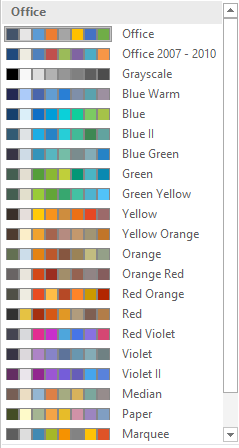
Similarly, you can select from collections of fonts that will be implemented throughout the document. It is an extremely easy way to alter the visual presentation of your document while maintaining a uniform, professional approach.
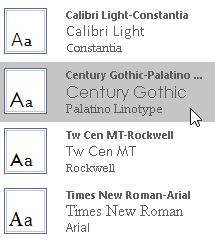
Document Formatting applies a complete «Style set» to your document. For instance, in the above video, the Heading 2 formatting Style is a standard, whereas in the next short clip, you’ll see the same Heading 2 Style (and Title Style) change as I rollover each Document Formatting option.
Another handy, but underused tool is Effects. Just as selecting a Theme alters the appearance of the text and formatting, selecting an Effect alters the appearance of each image throughout the document. There are options for regular Office, Glow Edge, Extreme Shadow, and plenty more, so you can select one that matches the voice of your work.
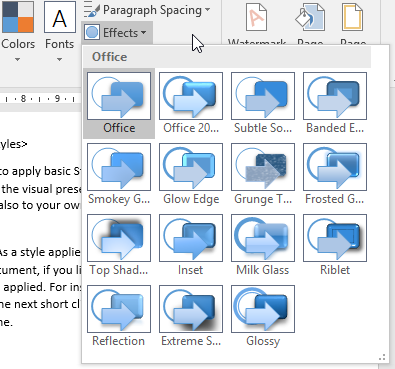
Templates
There are other extremely easy ways to apply consistent formatting throughout your entire document. Microsoft included literally thousands of free templates for you to use, covering a huge range of topics. Need a Business Report for a Graphic Design outfit? You’re covered. Need Valentine’s Day Sweetheart Supper & Pie Auction invitations (wat?!)? For some reason, you’re covered.
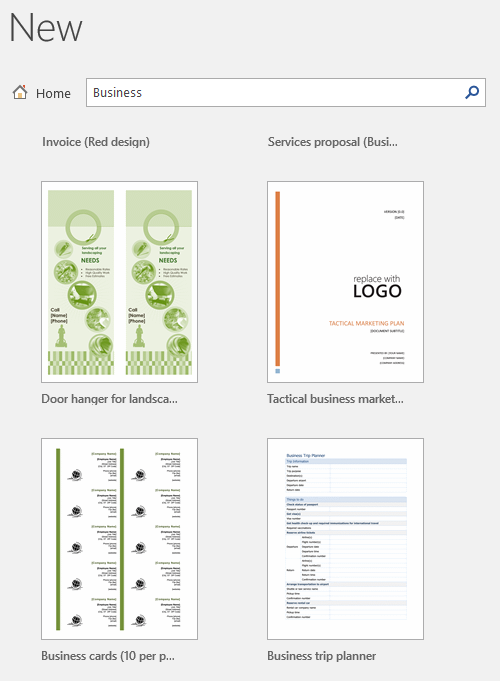
And although I poke fun at the latter of those examples, the templates can be tweaked to your own specifications extremely easily within Word, using the other design and layout tools available to you.
Choose any template, and open it. Look at the design of the document: where the indents are, where the text boxes are placed, if any specific styles have been applied, and then have a little play around. Move things, click things, change settings, and you’ll understand more about the composition of the template.
3 Advanced Formatting Tips
To round our Word layout settings article off, I’ll share three advanced formatting tips with you.
1. Section Breaks
Section breaks are a crazy useful formatting tool, especially if working on a document consisting of different facets of information that would benefit from an individual style. For instance, you can apply custom formatting to a single area, such as an alternative header or footer, or even a whole new page numbering system, but importantly leaving the rest of the document intact.
Head to the Layout tab, and select Breaks. It will open a drop-down menu containing various options:
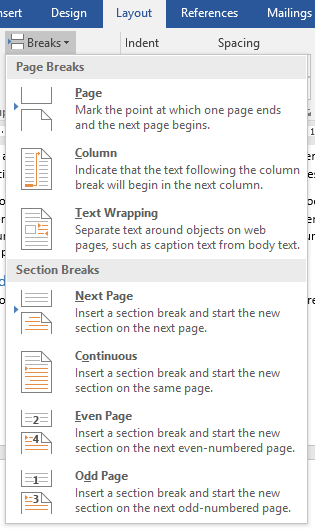
Select a section break that suits your document, but note that inserting a Next Page section break will also insert a Page Break, which can be problematic, if that isn’t what you’re after. In this case, use the Continuous Break option.
Once you implement a specific section style you like, you can always copy it to the next section break.
2. Using Find and Replace
This slightly overlooked formatting tool can be a lifesaver when performing editing duties, but using the Find and Replace tool can help you scour the entire document for the specific formatting issues you need to change.
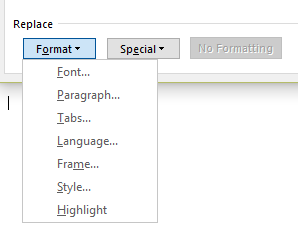
Press CTRL + H to open the Find and Replace tool. In the bottom-right you should spot Format, which opens a drop-down menu. You can now select from the range of additional replacement fields. Each options opens a new dialogue box where you can specify what you’re attempting to replace, and leaving the Find What/Replace With fields empty will change all of the matching formatting.
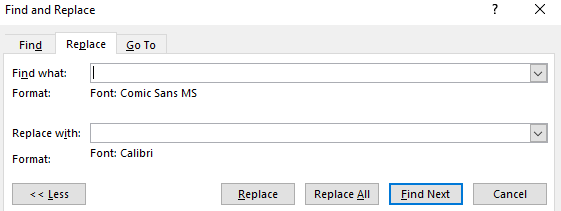
3. Formatting a List
You’d think altering the appearance of a numbered list would be jolly easy, but it can be surprisingly frustrating.
Head to the Home tab. In the Paragraph section, look for the paragraph symbol and select it.
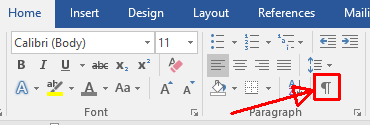
Look at the end of each entry in your numbered list.

You can now select the individual paragraph markers. When you’ve selected the list items you’d like to change (hold CTRL while making your selection to edit multiple options), head to the Home tab and select the format you’d prefer from the drop-down list options.

Bonus Tip: Display Shortcuts
Microsoft Word does a pretty good job of showing you ScreenTips where possible. Just hover over almost any icon and you’ll get a minute snippet of information detailing exactly what the button does. You can make these ScreenTips more interesting by adding their relevant shortcut, so each time you rollover to check, you can attempt to remember the shortcut instead.
Head to File > Options > Advanced. Under Display, ensure Show shortcut keys in ScreenTips. Then press OK.
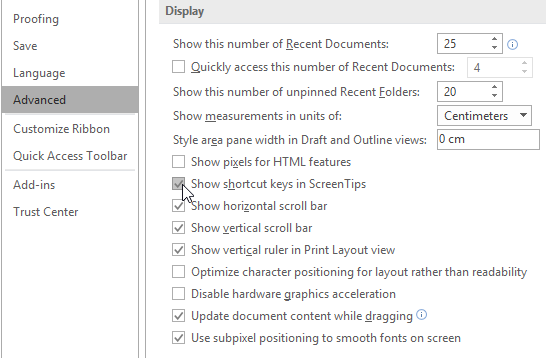
Bonus Tip 2: Configure Your Cut and Paste Settings
This is another tiny tip, but if you’re pasting snippets of text from other documents or programs, it can make a massive difference.
Head to File > Options > Advanced. Under Cut, copy, and paste you’ll see five options:
- Pasting within the same document
- Pasting between documents
- Pasting between documents when style definitions conflict
- Pasting from other programs
- Insert/paste pictures as
Select whether you’d like your pasted text to Keep Source Formatting, Merge Formatting, or Keep Text Only. There are also other options for you to consider. For instance, even after ensuring the formatting of any text copied from another program will be merged, I like to see the Show Paste Options button, just in case I need to make an alteration.
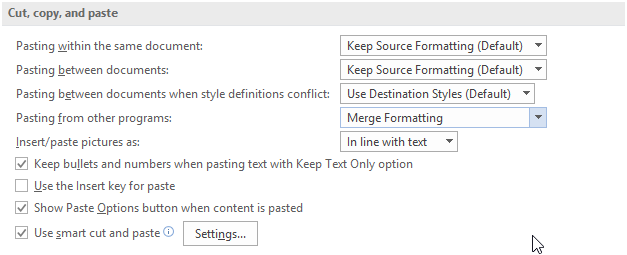
Formatting in Word Online
Word Online is part of the free online Office suite offered by Microsoft. It allows you to create and edit documents for free, provided you have a Microsoft account. Word Online offers much of the functionality of the desktop version, but there are some formatting omissions you might bump into.
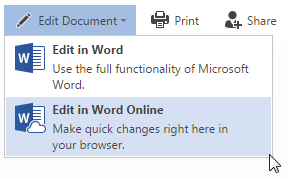
The base level of formatting is all as standard, but Online doesn’t come with support for Themes or Section Breaks, as well as only allowing «Portrait» as your document orientation. Similarly, while your indents and tab settings will be imported from the desktop version of Word (or elsewhere), Word Online also restricts rulers and gridlines, so adding more can prove difficult.
However, if you are looking to make some basic edits on the move, or simply have no need for the additional formatting power of Word itself, Word Online makes a solid replacement.
Go Forth and Make Things Pretty
You now have the knowledge to make any Word document beautiful, easy to read, with oodles of visually engaging formatting. Take some time to play with the formatting settings. If you familiarize yourself with the basic formatting settings, you’ll find more advanced formatting options a synch!
Now that you know how to format Word documents like a pro, try your skills on a custom brochure or pamphlet. You can start with templates and change them to your likes.
Select the words, paragraph, list or table to edit. On the Home tab, select a style. to expand the gallery.
Themes add a professional look to your document.
- Select Design > Themes.
- Point to a theme to preview how it will look.
- Select the theme you want.
Contents
- 1 Can I apply a design template to an existing Word document?
- 2 How do I create a design layout in Word?
- 3 How do I convert a template to a Word document?
- 4 How do I create a fillable field template in Word?
- 5 Why is there no Design tab in Word?
- 6 Where is the Design tab in Microsoft Word?
- 7 How do you Design a document?
- 8 How does a template help in creating a document?
- 9 How do you design a template?
- 10 Can you make a Word document fillable?
- 11 How do I make a Word document fillable and not editable?
- 12 How do I turn on design mode in Word?
- 13 Where is the Design tab in Word 2010?
- 14 How do you add the Design tab in Word 2007?
- 15 What is Layout tab?
- 16 How do I make a Word document creative?
- 17 How do I design a page layout?
- 18 What is meant by document design?
- 19 How do I create a template in Word 2019?
- 20 What are the steps in creating a new template?
Can I apply a design template to an existing Word document?
Apply a Word Template to an existing Word document
- Open the Word document you will apply template to, and click File > Options to open the Word Options dialog box.
- In the Word Options dialog box, please (1) click Add-ins in the left bar, (2) select Templates from the Manage drop down list, and (3) click the Go button.
How do I create a design layout in Word?
Click the File tab, and then click New. Under Available templates, click New from existing. Click a template or a document that is similar to the one that you want to create, and then click Create New. Make the changes you want to the margin settings, page size and orientation, styles, and other formats.
How do I convert a template to a Word document?
Click the top folder in the library and launch Template Manager. (See Open and Close Template Manager.) The Template Manager window appears. In the file list, select the templates you want to convert and click the Convert button.
How do I create a fillable field template in Word?
Go to File > New. In Search online templates, type Forms or the type of form you want and press ENTER. Choose a form template, and then select Create or Download.
Why is there no Design tab in Word?
If the Design tab is missing from your current installation, choose the “Main Tabs” option from the pulldown on the right, then turn on the checkbox for the “Design” main tab. Use the up or down buttons on the far right to move position of the selected tab within the main ribbon area.
Where is the Design tab in Microsoft Word?
Word online currently does not natively have a ‘Design’ tab. If you have an Add-in installed that creates buttons in the ‘Design’ tab, you will see the design tab appear.
How do you Design a document?
Document Design
- Use at least 12 point.
- Use a clear, easy to read font.
- Make important points stand out.
- Use bold or bigger sized font to emphasise text.
- Text should be set horizontally.
- Avoid splitting a word between two lines.
- Templates with accessible formatting.
- Use accessible formatting.
How does a template help in creating a document?
A template is a document type that creates a copy of itself when you open it. For example, a business plan is a common document that is written in Word. Instead of creating the structure of the business plan from scratch, you can use a template with predefined page layout, fonts, margins, and styles.
How do you design a template?
Edit your template
- Click File > Open.
- Double-click Computer or This PC.
- Browse to the Custom Office Templates folder that’s under My Documents.
- Click your template, and click Open.
- Make the changes you want, then save and close the template.
Can you make a Word document fillable?
To do this, click on “File” tab > “Options” > “Customize Ribbon“. Then under the “Customize Ribbon”, select the “Developer” checkbox and click “OK”. Step 2: Open a Word document and you will be able to make the Word document fillable.
How do I make a Word document fillable and not editable?
Head on to the “Protect” section on the ribbon and click the button labeled “Protect Document.” You should then click the button named “Restrict Formatting and Editing.” On the options that appear, select the one that says “Allow only this type of editing in the document” and pick “Filling in forms.” Once you’re done,
How do I turn on design mode in Word?
Turn on “Design Mode”. Highlight the placeholder text and make formatting adjustments as desired.
In the Word Options window,
- Click on “Customize Ribbon” in the left-hand sidebar.
- In the Tabs area on the right, check the box beside “Developer”.
- Click OK.
Where is the Design tab in Word 2010?
The main tabs in Word 2010 are the same as Word 2007 except the Office Menu has been replace with a “File” tab in Office 2010 and there is no “Design” tab.
How do you add the Design tab in Word 2007?
Customize Developer tab in Microsoft Word 2007
- Launch Word 2007.
- Click the Microsoft Office Button.
- Choose the Word Option button, and then the Word Option dialog box pops up.
- Click Popular, select the box at Show Develop Tab in the Ribbon and check it.
- Click OK, and then the Develop Tab will appear on the Ribbon.
What is Layout tab?
The Layout tab provides access to page display and layout options. These include page orientation and AutoFit, which is a feature that limits the width of columns in a report to be no wider than the largest value in each column. These options allow you to change the size or orientation of your report.
How do I make a Word document creative?
10 Simple Design Rules for Professional Microsoft Word Documents
- Keep It Simple, Less Is More.
- Choose a Context-Appropriate Typeface.
- Use Standard Font Size and Color.
- Use Standard Page Size and Margins.
- Align Paragraphs to the Left.
- Indent the First Lines of Paragraphs.
- Place Images Between Paragraphs.
How do I design a page layout?
Seven Ways to Create a Better Page Layout
- Align all elements with each other or a grid.
- Select a single visual or make strong visual connections.
- Keep odd or even elements in balance.
- Divide the page into thirds.
- Add white space in the right place.
- Use two or more of the same design element.
What is meant by document design?
Document design is the process of choosing how to present all of the basic document elements so your document’s message is clear and effective. When a document is well designed, readers understand the information more quickly and easily.Regardless of the form, the document development process remains the same.
How do I create a template in Word 2019?
Creating a new template in Word 2019
- Create a new document or open a document with styles that you can recycle.
- On the File tab, choose Save As. The Save As window opens.
- Click This PC.
- Click the Browse button.
- Open the Save As Type menu and choose Word Template.
- Enter a name for your template.
- Click the Save button.
What are the steps in creating a new template?
Answer
- Click File > Open.
- Double-click This PC. (In Word 2013, double-click Computer).
- Browse to the Custom Office Templates folder that’s under My Documents.
- Click your template, and click Open.
- Make the changes you want, then save and close the template.
Try it!
Change your document’s layout to get it just the way you want.
Margins
-
Select Layout > Margins.
-
Choose the margins you want or select Custom Margins to define your own.
Page Orientation
-
To change orientation, select Layout > Orientation.
-
Select Portrait or Landscape.
Line Spacing
-
Select Home > More Paragraph Options > Line Spacing.
-
Choose the spacing you want.
Want more?
Word for the web Quick Start
Change margins
Change page orientation to landscape or portrait
Change the line spacing in Word
Need more help?
If you’re creating a Word document with multiple page layouts, you may wish to make a single page landscape. Here’s how.
Photo Credit — iStockPhoto
When you’re creating Word documents, you have two-page layout options available—landscape or portrait. Portrait mode is the default option, but you can switch to landscape mode instead if you want your text sideways.
If you want to use both types of layouts in Word, you’ll need to use a few workarounds using section breaks and Word’s own page formatting options to do so. Here’s how.
If you want to quickly make one page landscape in Word, here’s what you’ll need to do:
- Open your Word document and place the blinking cursor at the start of the page you wish to change to landscape mode.
- Click on the Layout menu in the ribbon bar.
- Select Breaks > Next Page in the Section Breaks section. This will insert a section break and push your text onto a new page.
- In the Layout menu, press Orientation > Landscape. This will switch the current page and all the following pages to landscape mode.
- You’ll now need to turn the remaining pages back to portrait mode. Scroll down to the next page, then place the blinking cursor at the start of the page.
- Press Layout > Breaks > Next Page to insert a new section break.
- Click on Orientation > Portrait to switch the pages to portrait mode.
If you followed the steps correctly, you should now have one single landscape page, with all other pages remaining in portrait mode.
How to Make Specific Text Landscape in Word
If you don’t want all of the text on your page to appear on the landscape page, you can choose to make a landscape page that only contains specific text.
- To do this, start by highlighting the text that you want to appear on the landscape page.
- In the Layout menu, click on Margins, then select the Custom Margins… option at the bottom of the drop-down menu.
- In the Page Setup window, click on the Landscape option in the Margins tab, under the Orientation section.
- In the Apply to box, choose Selected Text.
- Click OK to confirm the settings you’ve selected.
You should now have a landscape page that contains the text you previously highlighted, creating a section break that uses a different page layout to the rest of your Word document.
You can use this method to turn an entire page landscape—to do this, select all of the text on the page before you start and repeat the steps above to complete the change.
Formatting Microsoft Word Documents
Now that you know how to make a single page landscape in Word, you can start creating documents with as many combinations of landscape and portrait pages as you want. This is where learning how to rearrange pages in Word might just come in handy.
If you’re looking for other ways to take your Word documents further, why not learn how to insert an Excel table into Word. For academic documents, you may wish to create a table of contents in Word to keep your document organized.
Page Layout in Microsoft Word refers to the arrangement or setting of certain pages or entire documents based on the requirements of the content being displayed.
Before beginning the process of taking printouts, it is very important to set the page’s margins, orientations, sizes of columns, and spacing.
Table of Contents
- Layout or Page Layout in Microsoft Word
- Page Setup:
- Paragraph:
- Arrange:

On the layout tab, we can see a number of different categories, such as Page Setup, Paragraph, and Arrange, and each of these groups contains a different set of commands to deal with.
Page Setup:

Margins: Margin is the space between the content beginning or ending in the document and the edges of the document pages. The default space between the content beginning or ending and the document edges of the margin is “Normal” which occupies the 1-inch space.
Orientations: Orientation is the page layout, in which the document is displayed or printed. The common types of orientations are Portrait and Landscape.
Size: Choose different page sizes in a word document based on your requirement. The default page size of a page is 8.5×11 inches, called Letter size.
Columns: Splitting (dividing) the text vertically in the pages called, columns. These include one column, two columns, three columns, left columns and right columns.
Breaks: Adding the new section breaks to the next pages or the current section on the same page to apply different Headers, Footers, Columns, Watermarks, or other works in the document pages wherever you want.
Line Numbers: Start each line in a document by using the Line Numbers in the Margin for your further reference even when the content starts with a Bulleted or Numbered List.
Hyphenation: The last word in a line moves down to the next line when it has not had enough space. When you select an Automatic or Manual Hyphenation, arrange some part of a word at the current line and move the remaining part of a word down. It is a great way for uniform spacing and saves spacing on your document page.
Paragraph:

On the layout tab, paragraph options include indent and spacing, these are explained below.
Indent: Indent is how far you want to move the paragraph away from the left margin or from the right margin. Generally, Professional material contains no indent, but some follow. According to Wikipedia “Professionally printed material typically does not indent the first paragraph, but indents those that follow.”
Spacing: Give more or less space above or below the selected paragraphs based on your requirement.
Arrange:

Position: Positioning is placing an object (picture, shape, etc.) on the page wherever you want. Whether it is on the top left, top centre, top right, middle left, middle centre, middle right, bottom left, bottom centre, or bottom right.
Wrap Text: Text wrapping means arranging the text around an object. By default, an object arranges in line with text when you insert an object (picture or drawing a shape) into a word document.
Bring Forward: Bring a selected object forward of all other objects.
Send Backward: Send a selected object backward from all other objects.
Selection Pane: Selection pane is one of the great ways to select, show, hide, and change the order of the objects in the word document.
Align: Placing objects (Pictures, Shapes, Icons, etc.) to margins, edges, or relative to one another in the word document.
Group: Grouping means making more objects together into one object to move, resize, and change their styles and effects as if they were a single object.
Rotate: Rotating an object is a circular movement in different degrees around a centre point of it. Rotate has various commands to rotate and flip the objects such as Rotate Right 900, Rotate Right 900, Flip vertical, and Flip Horizontal.
What is Layout or Page Layout in MS Word?
The Layout is the arrangement or the setting of some pages or whole documents based on the content requirement. Setting Margins, Orientations, Sizes Columns and Spacing of a page is a very important process before taking printouts.
Over the years, we here at Lulu have done our best to demystify the book publishing process. From basic word processor information to the book cover design to the complex role of a marketing campaign, we always try to give our authors the tools they need to be successful. Today I’ll brush up on five of the most common questions I see about page layout. Because we know that the overwhelming majority of our users do their design work in MS Word, I’ll make all of my examples regarding Word. But that doesn’t mean the principles don’t apply to any word processor or layout program.
All right, let’s dive in and look closes at five things you need to know when laying out your pages
First Steps
Before you do anything else, I recommend going to our Create Page and downloading the template for your book.
Select the size, binding, and format to get the correct template. Then open the ZIP file and grab the file mark “Template.” We preset this file to the right page size and added the margins and gutter for you. If you want to use an existing file or create your own template, you must follow two steps:
- Page Setup–Located under the File drop-down, you can select your page size from the list available or add a custom size. Note that US Trade 6 x 9 is not standard for Word, so you must add it.
Select “Manage Custom Sizes”, set the size to 6 x 9 (or your preferred size) and save this layout. If you use an unlabeled custom size, Word may not properly keep your page size when exporting. - Margins & Gutter–This is a section we’ll cover later, but for now remember the standard minimums:
Margins minimum = 0.5”
Gutter minimum = 0.2”
Now you have your page sized and some basic margins added. Take your manuscript and paste it into this template so we can start on your page layout!
Breaks
We touched on a lot of the concepts I’ll be covering today in a blog posted dedicated to book layout back in January. While that post focused on general layout information, we’re going to get into some real details about how to handle the most challenging and important elements of page design.
The first is the art of the “break.”
Microsoft Word (and all other word processors too) gives you an option to break a page. Essentially, what the command does is cause the current page to end. Any more content you add will appear on the next page.
Some users might say, “oh I just hold down Enter until I’m on the next page.”
Don’t do that! Ever!
Using a hard return to move to the following page might look fine on your screen. But will it look fine when you convert your file to a PDF so we can print it? Probably not.
Breaks—both page and section—divide the page dynamically, so that when you convert to a new file format, they will retain the proper space.
Pro Tip: When designing your interior, it’s wise to turn on Reveal Non-Printing Characters (also known as formatting marks) so you can see formatting marks on the page.
Page Breaks
A Page Break ends the content on the current page and moves to the next. For most books, you’ll use one to end every chapter. As I mentioned in the first part of this section, breaks control how the content is arranged on the page. A Page Break is the most basic and useful kind of break.
Aside from the need to push content from one page to the next, a Page Break is helpful in controlling how content is built around an image. Specifically, if an image is low on a page, follow it with a Page Break to keep text from appearing under the image.
Page Breaks allow you aesthetic control over page content.
Section Breaks
Section Breaks are a little more complex. They come in four flavors:
- Section Break (Next Page) – starts the new section on the next page
- Section Break (Continuous) – starts the new section on the current page
- Section Break (Odd Page) – starts the new section on the next odd page
- Section Break (Even Page) – starts the new section on the next even page
The essential accomplishment of a section break is to allow you to add unique formatting to specific areas of your file. For most book creators, the Section Break will be used to define where page numbers begin and how Header content appears.
Ever seen a book with the author name and chapter title on alternating pages on the top of the page? Setting that up requires applying Section Breaks.
As you see in the image, the page on the left shows the title of the first chapter (“Down the Rabbit Holes”) and the page on the right (the first page of chapter two) shows that chapter’s title (“The Pool of Tears”). The section break is splitting the file into two sections, allowing for the text in the Header of one section to vary from the text in another section.
Get Started
Create a free Lulu account today to print and
publish your book for readers all over the world.
Get Started
Create a free Lulu account today to print and publish your book.
Don’t worry about the Header yet, we’ll get to that in just a moment.
What we need to say finally about Section Breaks is how to choose which break to use.
You will use Section Break: Next Page. The Odd and Even break options force the next active section to the next odd or even page, respectively. This is fine to use, but remember that it will always break to the defined type of page. So, if you insert a Section Break: Odd Page on an odd page, it will skip the next even page (leaving it blank) and begin the next section on an odd page. This can cause unwanted blank pages.
Pro Tip: Use Section Breaks sparingly. If you plan to set chapter titles in the Header, you’ll need one at the end of each chapter. You’ll also need one between the front matter and body of your book. Otherwise, use page breaks to control the placement of content. This is vital to a consistent page layout.
There are a lot of elements that go into the Header and Footer. Let’s start with a look at the options available in the Word Ribbon for Header and Footer.
The first thing to notice is the information line below the Header. It tells you the page (even or odd), the section number, and the current status regarding previous sections. What is all this information about?
Link to Previous
In the Ribbon, you’ll see the button Link to Previous is currently selected. What this means is that the section your cursor is selecting (in the image Section 2 is selected) has a Header or Footer linked to the settings of the previous section.
Linking is useful for including page numbers across multiple sections. For example, a Header with the author name on every even page and the chapter title on the odd page will still have a continuous page numbering on the bottom. The Footers would need to be linked and the Headers would not.
You can control individual Header and Footer linking by clicking your cursor into the Header or Footer you want to link and check that box.
Different First Page
Different First Page is a setting you’ll find very useful if adding text to your Header.
In the example for Section Breaks, you may notice that I added a chapter title on the first page of the chapter (the first page of section 3). In most novels, this page doesn’t include a Header. And that’s where the “Different First Page” option comes in.
This setting is independent of the Odd & Even page setting. This means if you activate Different First Page and Different Odd & Even Pages, your section will have three independent Headers (or Footers)—the first page, the odd pages, and the even pages.
Different Odd & Even Pages
Checking this box set odd and even pages independently within the section. Now you can edit the Header or Footer for odd pages without impacting the even ones, and vice versa.
If you use any of these functions, be sure to apply the settings before adding content.
Header and Footer in action
You have a short book with seven chapters. Each page will feature the book title on the even page Header and the chapter title on the odd page Header. Page numbering will be continuous.
- Set a section break: next page after the front matter (on the page before Chapter 1).
- Set a section break: next page at the end of every chapter.
- Click on the Header in each section and select Different First Page, Different Odd & Even page, and de-select Link to Previous.
- Click on the Footer in each section and select Different Odd & Even pages and Link to Previous
- Add page numbers to the Footer (see the next section for more on Page Numbers).
- Manually add the book and chapter titles to the Headers.
Pro Tip: It is very important to apply and verify all the settings in your Header and Footer, in all sections, prior to adding your content.
Page Numbers
In this image, you see the Add Page Numbers panel. This screen also displays an option to show the page number on the first page of the section. Like the setting in the Ribbon, you can control whether the page numbering appears on the first page of the section. This is separate from the Different First-page option for Header and Footer.
Remember, linking sections will allow page numbering to continue from one section to the next.
Pro Tip: Add all section breaks and format your sections before you add the Header and Footer content (text or page numbers).
Front Matter
The front matter—title pages, copyright page, acknowledgments, table of contents, and introduction—rarely includes page numbering. Some books, particularly non-fiction books, will include long introductions with unique page numbers, such as Roman Numerals.
Once you’ve selected the Page Number command, you can click “Format” to change the details of the specific page numbers you’re adding.
Be sure to set the number you start on if you’re adding page numbering past the front matter. Your first chapter will probably be Section 2, so the default option to continue from the previous will not work (as Section 1 either has no page numbering or uses a unique numbering set up).
Using what you’ve learned about Section Breaks, you’ll set up page numbers per section. The “Link to Previous” option can apply to a series of sections to link the numbering continuously even if using multiple sections in the body.
Margins/Gutter/Bleeds
Lulu tries to make the Margins and Gutter easy for you with some pre-formatted templates. But you need not use these and if you’ve already begun formatting your file it may be more work than it’s worth to paste the contents into a pre-formatted file.
Let’s assume you’re working with your own file and you’ve already set the page size. Is your book going to need to be Full Bleed?
Briefly, Full Bleed means you have content (almost likely images) that should stretch to the edge of the page. If you do, you must work with a page preset to allow for this. Luckily, it’s simple to do!
What you’ll do is add 0.125” to the margin on all sides of your file. If you’re making a 6 x 9 book and need full bleed, set the page size to 6.25 x 9.25. Then add your content right to the edge of the page, staying aware that the extra 0.125” will be trimmed away.
Pro Tip: If you’re creating a book with a lot of images and Full Bleed, use software like Adobe Photoshop or InDesign to create your pages. MS Word and other word processing tools are best suited to text-based content.
Create Page Layout Templates
I like to save all the common sizes (under File > Page Setup) and a Full Bleed version so I can easily set my page size:
Okay, so you’ve got your page sized correctly. And you added margins, and a gutter based on our minimums. But what are these things?
The margins are the space around the edge of the page—the white space framing your text. Go pick up any novel and you’ll find a margin. It’s important to hold to this convention because it makes reading much easier and more comfortable for your reader. Could you imagine a page, top to bottom edge to edge, covered in words? Yikes.
The margins on top and bottom will also be where your Header and Footer content will live. Be sure to check the Format > Document > Layout settings to position your Header and Footer the right distance “from the edge.”
If you have a 0.5” margin and you set the Footer to appear 0.8” from the edge, adding page numbers will “hide” the actual number behind the content!
Why?
Because the bottom Margin is smaller than the Footer! I recommend setting the Header and Footer distance to match the top and bottom margins. Once you’ve got your page numbering added, you can tinker with this distance to adjust the position of the page numbers.
Pro Tip: Be careful to check the “Apply to” drop-downs in any formatting panel your working in. If it lists “This section” any change you make will only apply to the section your cursor is in! Most often you’ll want to use “Whole document” to keep your settings uniform.
Text Layout
You got the page set up and ready to go. Your Headers and Footers are all in place. Now you need to consider the actual layout of the text on the page.
Thankfully, laying out the text isn’t hard.
The most important thing to do when creating your body text and preparing it is to use the same style. Style based formatting is the standard way to apply fonts, spacing, size, color, and any other feature to your text. Control your styles with the Styles Panel from the Ribbon.
I highly recommend learning about styles. They will streamline the page layout and provide you control over your book’s interior design. With style-based formatting you can:
- Set the line spacing
- Set the text size
- Select the font
- Create unique styles for different sections (including chapter titles, quotes, lists)
- Maintain consistency throughout your file
- Position the text on the page consistently
Text and Page Layout Options
And that’s only a tiny portion of the options you’ll have. Just right-click on a style and select ‘Modify’ to see the entire list of options you have:
The most important and often-used options will appear in the panel, and you’ll notice in the image above I’ve expanded the drop-down on the lower left. Additional options can be accessed here to further customize your style.
Word also has a handy feature for creating a table of contents using styles. If you apply any content that should appear in the table of contents a Heading 1, Heading 2, or Heading 3. Just use the Insert>Table command and select the Table of Contents options. The table will use your Heading styles to populate a list with the styled text and a page number!
One last thing to consider with your text formatting is some best practices. There’s always some room for customization in your book, but in general, you want to be certain your book is enough like other books that readers will actually read it!
Text Settings
Justified Text – Word will default to aligning your text to the left. But we should set all text to ‘Justified.” This setting will automatically adjust the kerning and spacing to make your text fill the space between the left and right margins. Go look at any printed book and you’ll see that, aside from the last line of a paragraph, it justifies the text.
Line Spacing – There isn’t a hard and fast rule for line spacing, but increase the space between paragraphs slightly. Usually, 1.25 normal spacing is enough. For the lines themselves, there isn’t any need to provide additional spacing.
Text Size – Text should be 12 points. If you’re publishing a long work and want to reduce page count, 10 point is the smallest you should use. Likewise, for a “large print” edition, use 16 points. For other texts like Chapter or Section titles, exercise your creativity. Just know your page size; don’t use 48 points in a 6 x 9 book, otherwise, you’ll end up with an entire page just for the chapter title!
Indenting – There isn’t a strict rule, but it’s not a bad idea to indent the first line of paragraphs 0.5” or less.
Finalizing the File
The list and instructions here touch on some common issues self-published authors might run into while creating their book files. But the list is hardly comprehensive. MS Word is a rich and powerful word processor despite being cumbersome to use. There are features upon features available.
Don’t get overwhelmed though. Follow the many guides out there and you’ll end up with a working file to publish your book!
Get Started
Create a free Lulu account today to print and
publish your book for readers all over the world.
Get Started
Create a free Lulu account today to print and publish your book.

Paul H
Paul is the Content Marketing Manager at Lulu. When he’s not entrenched in the publishing and print-on-demand world, he likes to hike the scenic North Carolina landscape, read, sample the fanciest micro-brewed beer, and collect fountain pens. Paul is a dog person but considers himself cat tolerant.



















































































